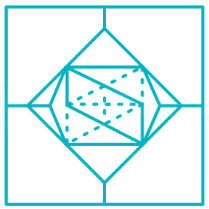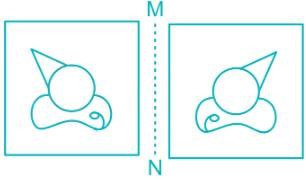EMRS Junior Secretariat Assistant Mock Test - 2 - EMRS MCQ
30 Questions MCQ Test - EMRS Junior Secretariat Assistant Mock Test - 2
From the given answer figures, select the one in which the question figure is hidden/embedded.


If a mirror is placed on the line MN, then which of the answer figures is the right image of the given figure?


A series is given, with one term missing. Choose the correct alternative from the given ones that will complete the series.
6, 9, 15, 27, ?, 99
From the given words, select the word which cannot be formed using the letters of the given word.
STUPENDOUSNESS
If 2cosec2A = x, then find the value of x?
If the measures of the angles of a triangle are in the ratio. 1 ∶ 2 ∶ 3 and if the length of the smallest side of the triangle is 10 cm, then the length of the longest side is
A cricketer has a certain average of runs for his 6 innings. In the seventh inning he scores 100 runs, thereby increasing his average by 7 runs. His new average of runs is
Which one of the following mineral does not contain oxygen?
Tendons and Ligaments are what kind of tissues?
Which North-eastern Indian state is the home to India’s largest rail-cum-road bridge?
The number of biogeographical zones in India are:
In a rainforest, the vegetation that grows under the shade of a canopy is known as
When was the Indian Constitution amended for the first time?
Where is the Headquarter of African Union?
‘Davis Cup’ is associated with the game of
Who is considered the greatest of the early Chola kings?
Who discovered the ABO blood group system?
What is the name of the process where solid is directly converted into gas?
Which vaccine is primarily used against tuberculosis?
DIRECTIONS: Identify the incorrect sentence out of A, B and C. If none of these have a error, choose D.
Lime and soda (A) / is (B) / a digestive drink. (C) / no error(D)
Direction For question : As the Heart of Darkness makes its way into the savage shadows of the African continent, Joseph Conrad exposes a psycho-geography of the collective unconscious in the entangling symbolic realities of the serpentine Congo. Conrad’s novella descends into the unknowable darkness at the heart of Africa, taking its narrator, Marlow, on an underworld journey of individuation, a modern odyssey toward the center of the Self and the center of the Earth. Ego dissolves into soul as, in the interior; Marlow encounters his double in the powerful image of ivory-obsessed Kurtz, the dark shadow of European imperialism. The dark meditation is graced by personifications of anima in Kurtz’ black goddess, the savagely magnificent consort of the underworld, and in his porcelain -skinned Persephone, innocent intended of the upper world. “Africa,” wrote Graham Greene, “will always be the Africa in the Victorian atlas, the blank unexplored continent in the shape of the human heart.” The African heart described by Greene “acquired a new layer of meaning when Conrad portrayed the Congo under King Leopold as the Heart of Darkness, a place where barbarism triumphs over humanity, nature over technology, biology over culture, id over super ego.” The unknown and uncharted topography of the African continent first beckoned Conrad’s narrator, Marlow, into its depths in his boyhood: “Now, when I was a little chap I had a passion for maps. I would look for hours at South America, or Africa, or Australia, and lose myself in all the glories of exploration”. When Marlow was grown and Africa was no longer a blank space on the map, but rather “a place of darkness,” there was still one river there that drew him especially, “a mighty big river, that you could see on the map, resembling an immense snake uncoiled, with its head in the sea, its body at rest curving afar over a vast country, and its tail lost in the depths of the land”. This same deep place, the Congo, that had seduced Conrad’s ivory hunting Kurtz into the horrors of its savage embrace had, in 1890, lured Conrad himself into adventure that turned him from sailor to writer and severely affected his health for the rest of his life. As the voyage up the Congo pro ved fateful for the development of Conrad’s narrator, Marlow, it was equally fateful for Conrad’s individuation, as he reflects in his letters “Before the Congo I was just a mere animal.” Hillman, in “Notes on White Supremacy” reminds us that, like Conrad, both Freud and Jung were called to venture into the shadowed continent and vestiges of their journeys still colour our psychological language: The convention informing geographical discoveries and the expansion of white consciousness over Africa continue to inform psychic geography. The topological language used by Freud for “the unconscious” as a place below, different, timeless, primordial, libidinal and separated from the consciousness recapitulates what white reporters centuries earlier said about West Africa. From Conrad’s Heart of Darkness to van der Post’s Venture to the Interior, Africa and the unconscious allegorize the other place.... “Just don’t stay in the topical colonies too long; you must reign at home,” writes Freud in 1911 to Jung, who himself made the African journey fourteen years later, describing the vast lands and dark peoples he encountered in language he applies as well to the immemorial unconscious psyche.... Part of psychology’s myth is that the unconscious was “discovered” as its contents are “explored”. Thus Africa has become a topology of the mind — its location, its shape, its cultures, its textures, its rhythms, its foliage, its hues, its wildness — all calling forth something lost in the psychology of the white European. It is with an understanding of our destiny to explore that symbolic lost continent within ourselves that we can begin to appreciate the prescience of Jungian psychology in Conrad’s Heart of Darkness.
Q. The author compares Congo to an animal/a reptile. What is this figure of speech called?
उसने कालू की पिटाई कर दी इस वाक्य में क्रिया का कौन सा रूप है?
a) Cache memory is a very high-speed memory (high-speed memory) placed between the random access memory (RAM) and the central processing unit (CPU).
b) The logic unit of the CPU compares numbers, letters and special characters.
c) The control unit coordinates the input and output devices of the computer.
Examples of Web Browser are
i) Mozilla
ii) Opera
iii) Netscape Navigator
iv) Netscape
v) Internet explorer
vi) Mozilla Firefox






















